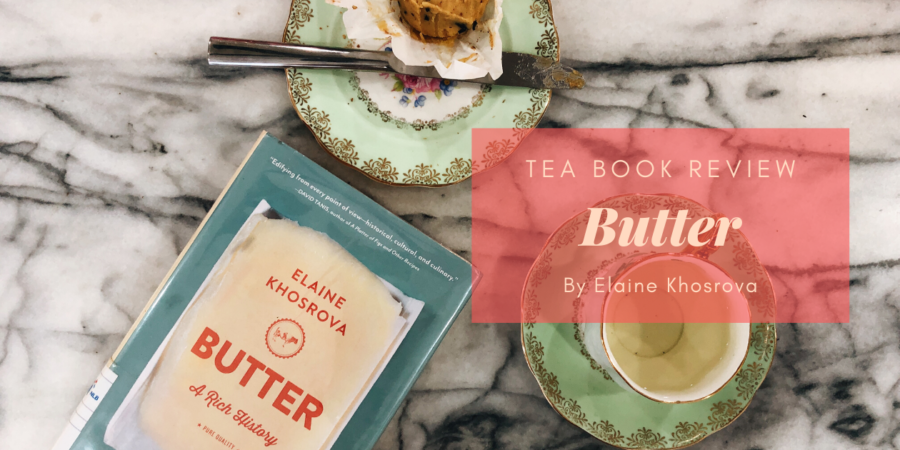There isn’t a good reason for me to be shocked by the fact that butter has a book dedicated to it, given that I have multiple books dedicated to tea and that is also a food product, but I was surprised and very intrigued. I grew up eating margarine on toast but in the past decade, my family has switched to butter and I love it. Obviously, I wanted to know more about this amazing food that goes on toast, in cookies, etc.
Butter is divided into two parts: the story of butter and recipes involving butter. The first part covers how butter is made around the world, how it has developed, and what the butter industry looks like today. It was also the reason why I went around asking my friends: “do you know that yak butter costs twice as much as cow butter in Bhutan?”
One particular chapter that I enjoyed, apart from the one on modern artisan butter, is the chapter entitled “sacred and spiritual”. It’s a chapter that looks at butter in various sacred texts and religions. I never knew how prevalent butter (and butter equivalents, such as ghee) were in various religions until now!
Part two of the book is a collection of recipes. Apart from the obvious recipe of “how to make butter”, Khorsrova has also collected a range of recipes that allow you to bake and cook with butter. Each recipe comes with a chatty preface that tells you more about the dish and what type of butter you should be using. I am honestly tempted to get a copy of this book just for this section because many of the recipes (such as the lemon curd and the scones) sound fantastic.
Overall, this is a fun book about something that I overlooked for far too long. If you’re eaten butter or you like butter or you’re just into food history, you’ll want to pick this book up.
If you liked this, try…
Butter vs Margarine episode of Stuff You Missed in History Class – If you were intrigued by what the book was saying about the butter vs margarine health wars, this episode of Stuff You Missed in History Class goes deep into detail about the topic.
The Poison Squad – This book is about the Dr Wiley’s fight against fake foods in the US, but you will come away from this with an appreciation of how lucky we are to have access to actual foods. It’s not related to butter, per se, but the book’s talk about the future of butter reminded me of this sordid part of food history.
Meraki Butters – I came across this local butter brand just after reading this book and fell in love with their kombu butter. They have three types of compound butters: Mala, Kombu, and Salted Egg Yolk. If you’re in Singapore and you want to jazz up your toast, you have to check them out.
Maison du Beurre – If you’re in Tokyo, there is a fantastic shop called Maison du Beurre that specialises in echire butter. They don’t just sell echire butter, they also use it to make croissants and other pastries. I visited this place during my time in Japan and the croissants there were honestly some of the best I’ve ever had.

Oh, it sounds like I would love this book!
When we lived in SE Asia, I gave up on eating butter because the tinned butter product that was designed to keep on tropical store shelves tasted nothing like the real thing. My husband kept doggedly eating it, but he called it “yellow stuff to put on bread.” 😀 However, occasionally we could get a very good brand of French butter that was better than anything I’ve had in the States.
Later, I read Good Calories, Bad Calories and found out that margarine was a huge scam, supposedly better for us than butter, but actually much worse.
All of these books sound really terrific.
Our butter scene has developed! You can even find clotted cream here (in certain stores).
Yeah, after learning about margarine I try to avoid it unless possible. However, I grew up eating margine with brovil toast and butter makes it tastes so different so we have a tub of margarine in the house for that :p
You are right, some recipes just call for certain products. Here it’s Miracle Whip. 🙂
Interesting! My parents remember that during the WWII era, oleomargarine was white in color so it came with coloring that the consumer stirred into it so that it would look like butter.
Interesting! Did your parents stir the coloring into the oleomargarine? Or did they not bother since it doesn’t affect the taste? Our margarine here is all coloured to look like butter (but it comes in tubs so the packaging is different from butter, which is mostly in sticks)
Yes, they did stir in the coloring because then it looked more appealing.
I’ve heard of this book and have always meant to pick it up because of its subject, but I didn’t know it had a whole section of recipes (which are always fun to try out). And that butter plays a role in religion is an even bigger surprise! This is all interesting, and it does make me wonder how much I know about the foods I consume in everyday life!
Honestly after reading this and about tea, I feel like I don’t know very much at all!